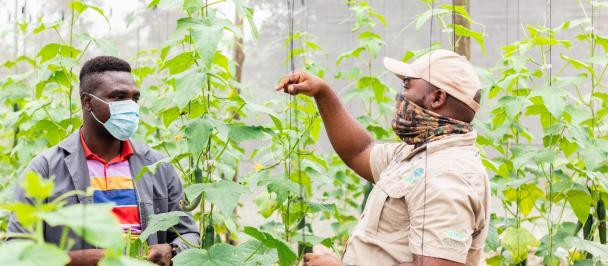--- Image caption ---
Nata, Botswana, May 19, 2021 – The Global Environmental Facility Small Grant Programme (GEF/SGP) through the United Nations Development Programme (UNDP) in partnership with Nata Conservation Trust, the Ministry of Environment Natural Resources Conservation and Tourism through the Department of Forestry and Range Resources, Tutume Sub-District Technical Advisory Committee and BirdLife Botswana held an event to launch Fire Management Strategy and official handing over of the fire fighting equipment to the communities in Nata area (Nata, Maposa, Manxotae and Sepako).
The fire management strategy and the firefighting equipment that were officially launched and handing over were developed and procured by Nata Conservation Trust through the funding (P332,845.52) from the Global Environmental Facility Small Grant Programme (GEF/SGP) implemented by the United Nations Development Programme (UNDP) to undertake a project entitled ‘Sustainable Management of Rangeland and Natural Resources.’ The launching of the strategy and handing over of the firefighting equipment marked the end of the project for the Trust.
Nata Conservation Trust is a community-based organization established in the area to protect and manage natural resource as well as improve the livelihoods of the local communities. One of the areas managed by the Trust is the Nata Sanctuary. The sanctuary has overabundance of natural resources amongst them the greater and lesser flamingos. The Sanctuary was Gazetted by Botswana government as a flamingo sanctuary to provide formal protection, is a home to approximately 165 bird species and it is one of the world's most important breeding sites for greater flamingos and lesser flamingos.
According to UNESCO, it is one of the three breeding grounds of flamingos in Africa and the largest. This is an important reproduction site for flamingos, the waters of the salty lake are rich in food for these beautiful birds; the pink greater flamingos are fed with artemies a family of shrimp living in salt and alkaline waters.
For a long time people of Nata area have been affect by reoccurring of veldfires which pose risk to their life, property/infrastructure, local economies as well as the flora and fauna. It is noted that the lesser flamingo is decreasing in population according to the IUCN red list of threatened species, and if people don’t do nothing about the veld fires which continues to affect the ecosystem soon Botswana will not have any lesser flamingos roaming around Nata a problem which will affect the business specifically Avi- tourism or bird tourism.
Fire is an integral part of savannah’s ecosystem and Batswana have used it for various purposes since time immemorial. Traditionally, fire has been used as a management tool to control vegetation structure and composition, for hunting and to recycle nutrients locked in live and dead biomass. These uses have continued up to today particularly in savanna ecosystems of southern Africa and northern parts of Australia. However, improper use of fires often lead to veld fires, which are blazes that get out of control, destroying extensive tracts of forests and grasslands and may result in the loss of biodiversity and human life and it can also lead to structural fires.
The Makgadikgadi ecosystem is one of the fire prone areas in Botswana due to the vegetation composition found in the area. It is against this background that communities of Nata, Maposa, Manxotae and Sepako through the auspices of Nata Conservation Trust developed the project aimed at sustainable management of range and natural resources in their area. As key outputs from the project was the; capacity building of community members on fire management, development of the fire management strategy and the procurement of firefighting equipment.
Strategic planning was deemed important because it explains shared understanding of veldfires together with their risks and ways of combating the risks. This fire management strategy will empower people of Nata and neighboring villages to work together and overcome the problem which continue to affect their area. The management plan also will enhance the resilience of the natural ecosystem through sustaining biological diversity and human livelihoods in times of fire outbreaks. To perform and achieve all this, people from relevant departments, stakeholders, communities and experts were consulted to benefit from their skills and knowledge. This helped identify information, opinions and local factors around the villages.
The general objective of this strategy are: 1) to provide guidance to communities in the Nata, Manxotae, Sepako and Maposa areas on how to prevent and manage veld fires. 2) wildland suppression. The strategy is intended to address the Nata wildfire problems by focusing on four key areas: 1) Restore and Maintain Rangelands; 2) Fire Adapted Communities 3) Improved Response to Fire; 4) Emergency Medical Support.
About Global Environment Facility (GEF) Small Grants Programme (SGP): The Global Environment Facility (GEF) Small Grants Programme (SGP) is a corporate programme of the GEF. The programme is implemented by the United Nations Development Programme (UNDP) on behalf of the GEF, World Bank, United Nations Environment Programme (UNEP) and United Nations Development Programme (UNDP) and executed by United Nations Office for Project Services (UNOPS). The programme provides grants and technical support to communities through Civil Society Organizations (CSOs) comprising of Non-Governmental Organisations (NGOs) and Community Based Organisations (CBOs) as well as Academic and Research Institutions.

 Locations
Locations
